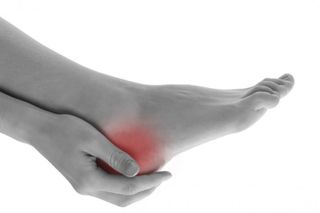Diabetic Footwear Process
- A Comprehensive Diabetic Foot Exam is performed by our office. This exam allows us to document any complications or conditions relating to your need for diabetic footwear.
- Once your exam is complete, we will go over what shoe options we have that will best suit your individual needs.
- Documentation is sent to the MD/DO overseeing your diabetes for approval.
- Once approval has been given by MD/DO, we will order your diabetic footwear.
- After your diabetic footwear arrives in our office, you will be asked to come back for the official fitting.
- During the fitting process, careful attention is given to the fit and comfort of your diabetic footwear.
- After a successful footwear fitting, enjoy the comfort and benefit of your new diabetic footwear!
If you have any additional questions or would like to schedule an appointment to begin the diabetic footwear process, please contact our office at (334) 671-1441. We look forward to hearing from you!

Heel Pain
A majority of people will experience heel pain at some point in their life. There are multiple potential causes of heel pain with the most common causes being plantar fasciitis, Achilles's tendinitis, plantar and posterior heel spurs as well as bursitis. The good news is that 90% of heel pain patients seen in our office have their pain resolved without having to have surgery. The other 10% go on to have a simple procedure which is usually completely healed in a month. By far the busiest time of year for our office to see heel pain cases is in the summer when flip flops and sandals put additional stress on the soft tissues of the feet due to their non-supportive nature.
Plantar fasciitis is a painful inflammation of the big ligament on the bottom of your foot. If you pull your toes up it can be strummed like a guitar cord in the middle part of the bottom of the arch. After sleeping or sitting for a while the fascia becomes shortened (contracted) and cold. When standing up after this period of inactivity the first few steps on this cold, contracted fascia often cause excruciating pain for the patient who suffers with plantar fasciitis. This is called post static dyskinesia and is one of the hallmarks of plantar fasciitis.
Heel spurs usually result from excessive tension on the bone at the insertion of a tendon or ligament. In the case of a heel spur on the bottom of the heel (plantar heel spur) it results from the pull of the ligament which in this case is the plantar fascia. In the case of a posterior heel spur on the back of the heel it results from the pull of a tendon which in this case is the Achille’s tendon which is the tendon for the calf muscle (gastrocnemius and soleus muscles) at the back of the leg.

Bunions and Hammertoes
Bunions and hammertoes are the most common structural deformities we see in the feet. Initially they may not be painful when the deformity is still flexible but when the toes become rigid and range of motion becomes restricted it often becomes painful for the patient, especially while wearing shoes. Modification of shoe gear such wearing wider, deeper shoes will often accommodate this problem as well as the use of orthotics which provide needed support for a foot suffering from bunions and hammertoes. Orthotics help to keep the foot in a neutral position where the muscles of the foot and leg can work more efficiently. In some cases it is necessary to perform corrective surgery to realign bunions and hammertoes. What procedure is chosen depends on the severity of the deformity. An x-ray taken in the office can determine how severe the deformity is and what procedure is best suited for the individual patient.
